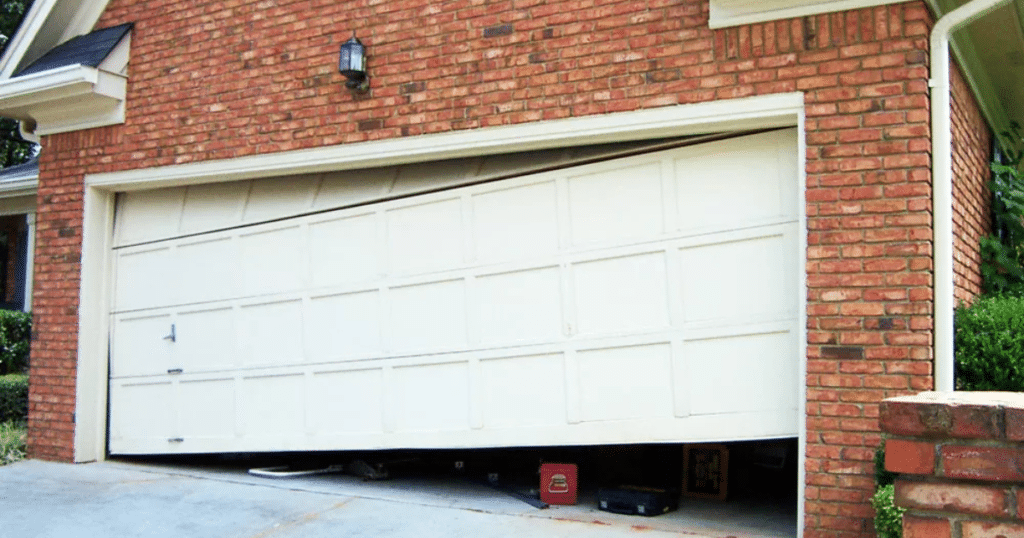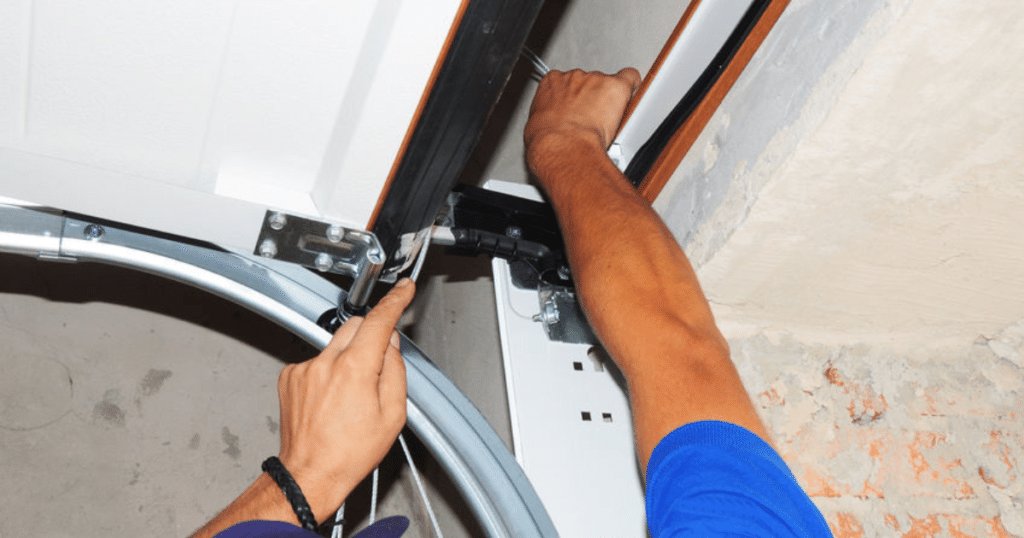Do you need to know how to fix a garage door that is off track fast and safely? Follow our expert-backed steps to get your door back on track without risking further damage or injury.
Garage doors can go off track for various reasons, including accidental impact, worn-out rollers, broken cables, or obstructions on the tracks. Identifying the root cause is crucial before any repair begins. If the problem is ignored, it can further damage the door panels, tracks, or opener system.
When your garage door doesn’t operate smoothly or appears lopsided, it’s usually a clear indication that it’s off track. Acting to minimize further issues and ensures safety for everyone in your household.

Safety First: What to Do Before You Begin the Fix
Before you attempt into how to fix garage door off track, it’s absolutely essential to take proper safety precautions. Garage doors are heavy and operate under a significant amount of tension, especially if springs or cables are involved. Skipping safety steps can result in injury or further damage to the door, so take a few moments to prepare carefully.
1. Disconnect the Opener: Start by unplugging or disengaging the automatic garage door opener. This prevents any accidental activation while you’re working. Many openers have a manual release cord—usually red and hanging down from the opener rail—that you can pull to disconnect the door from the motorized system. This step ensures the door won’t suddenly move due to a signal or power surge.
2. Use Proper Safety Gear: Always wear protective gloves and safety glasses before getting started. Gloves will help protect your hands from sharp metal edges, pinching points, or debris. Safety glasses shield your eyes from dust, small particles, or accidental contact with tools or springs. Even if the door looks stable, working around moving parts poses risks that gear can help mitigate.
3. Stabilize the Door: If your garage door is crooked, hanging, or tilted to one side, resist the urge to try to close or straighten it forcefully. Doing so can worsen the problem or cause serious injury. Instead, use locking pliers or C-clamps to secure the tracks and keep the door in place. Clamp them onto the tracks just below the lowest roller to prevent the door from sliding downward unexpectedly.
4. Assess the Situation Honestly: Take a step back and evaluate the severity of the problem. If the door appears to be under high tension, or if cables or springs have snapped or become unwound, it’s better not to proceed on your own. These components can be extremely dangerous to handle without proper training. In such cases, don’t hesitate to call a professional technician who is experienced in garage door repairs.
Remember, taking time to prepare and understand the risks involved isn’t a delay—it’s a crucial part of ensuring your safety and preventing more extensive damage. Always err on the side of caution when dealing with heavy machinery like garage doors.
Hands-On Guide: How to Fix Garage Door Off-Track
Once you’re ready and the area is secure, follow these steps to restore your garage door to working condition:
1. Check and Clean the Tracks
Begin by thoroughly inspecting both the vertical and horizontal tracks on either side of the garage door. Look for any signs of:
- Debris such as dirt, leaves, or hardened grease
- Dents or warping in the metal
- Misalignment that may have caused the rollers to slip out
Use a level to make sure the tracks are properly aligned and straight. Even slight warping can throw the door off balance. Clean the inside of the tracks with a soft cloth and a mild household cleaner to remove any buildup that could obstruct smooth movement. Avoid using harsh chemicals or lubricants at this stage, as they can cause residue.
2. Realign the Rollers
Once the tracks are clean and assessed, locate the area where the rollers came off. Using a pair of pliers, carefully open the edge of the track just enough to create space for the roller to slip back in. Gently guide each roller back into its correct position, ensuring they sit fully inside the track channel.
After realigning the rollers:
- Use a rubber mallet to lightly tap the track back into shape.
- Ensure that it is closed securely but not so tight that it pinches the roller.
- Test that the rollers can move freely along the track without sticking or wobbling.
Take your time with this step—proper roller alignment is key to the door’s smooth operation.
3. Tighten Loose Hardware
Loose or worn hardware is often a contributing factor in a garage door going off track. Carefully inspect all visible brackets, bolts, and hinges along the door and track system. Using a wrench or socket set:
- Tighten any loose fasteners
- Replace damaged or missing screws
- Check that the brackets holding the tracks to the wall are firmly in place
This step not only stabilizes the current repair but helps prevent future derailments caused by vibration or daily wear and tear.
4. Reconnect the Door Opener
Before reconnecting the automatic opener, test the door’s manual movement:
- Slowly lift and lower the door by hand to check for smooth, even motion
- Listen for unusual sounds or resistance, and recheck alignment if needed
Once you’re confident that everything is operating properly, reattach the garage door opener:
- Engage the manual release back into its track or plug the opener back in
- Use the wall button or remote to activate the door automatically
- Observe at least one full cycle (up and down) to confirm smooth operation
Preventive Tips: Keep Your Garage Door on Track
Perform Regular Inspections
Take a few minutes each month to visually inspect the entire new garage door system. Pay close attention to:
- Rollers: Look for signs of cracking, chipping, or uneven wear. Worn rollers can slip out of the track or cause jerky movement. If you notice this happening, it’s important to understand how to fix garage door off track problems before they get worse.
- Cables: Check for fraying, slack, or corrosion. Damaged cables can affect the door’s balance and put strain on the track.
- Tracks: Ensure tracks are aligned, clean, and free of dents or buildup. A bent or dirty track can easily knock the door off course.
Catching early signs of wear or misalignment allows you to address small issues before they turn into larger, more costly repairs.
Lubricate Moving Parts
Smooth operation relies on well-lubricated components. Use a silicone-based lubricant—not grease—on the rollers, hinges, and springs every few months. This reduces friction, prevents rust, and ensures that parts move freely and quietly.
Avoid over-applying lubricant, as excess can attract dust and grime. A quick spray and wipe-down with a cloth is usually all that’s needed.
Don’t Force the Door
If your garage door resists movement—whether manually or when using the opener—don’t try to force it open or closed. Forcing the door can:
- Knock the rollers off track
- Damage the opener motor
- Put undue strain on the cables and springs
Instead, stop immediately and inspect the door for blockages or misalignment. For more serious issues, it’s best to contact a professional.
Proper maintenance plays a huge role in reducing the need for emergency fixes.

FAQs About Off-Track Garage Doors
Why did my garage door go off track in the first place?
Common causes include vehicle impact, worn rollers, broken cables, or an obstruction in the track.
Can I fix an off-track garage door myself?
Yes, if it’s a minor issue like a single roller out of place and you’re confident with tools. For complex issues, it’s safer to call a professional.
Is it dangerous to operate a garage door that’s off-track?
Absolutely. Operating an off-track door can result in serious injury or property damage.
How can I prevent my garage door from going off track again?
Routine maintenance, keeping tracks clean, and avoiding manual force can significantly reduce the risk.
What should I do immediately after my garage door goes off track?
Stop using the door and avoid trying to force it open or closed. Disconnect the opener to prevent further damage and contact a garage door technician right away. Clear the area to keep everyone safe until it’s fixed.
Conclusion
Fixing a garage door off-track may seem intimidating, but minor issues can be resolved at home with the right guidance and caution. Understanding how to fix a garage door off-track equips you with the confidence to take immediate action.
Still, not every situation is suitable for DIY solutions. If you’re unsure or multiple rollers have derailed or the door has suffered impact, it’s best to contact a certified garage door repair expert.
End Note
DoorJam Garage Repair is your go-to source for professional garage door services in Raleigh, Durham, and beyond. We bring years of hands-on experience addressing everything from off-track doors to complex opener malfunctions.
Our garage door repair services are tailored to meet each homeowner’s needs. Whether you’re in Durham, Raleigh, or Wake Forest, our local experts deliver fast, reliable solutions backed by a satisfaction guarantee.
Want to know more about who we are? Visit our About Us page. Need comprehensive maintenance or installation? Explore our full range of garage door services. You can also stay connected with us on Facebook and Instagram.
Need help now? Use our contact form to schedule your emergency repair today. We’re always ready to get your garage door back on track—safely and efficiently.
